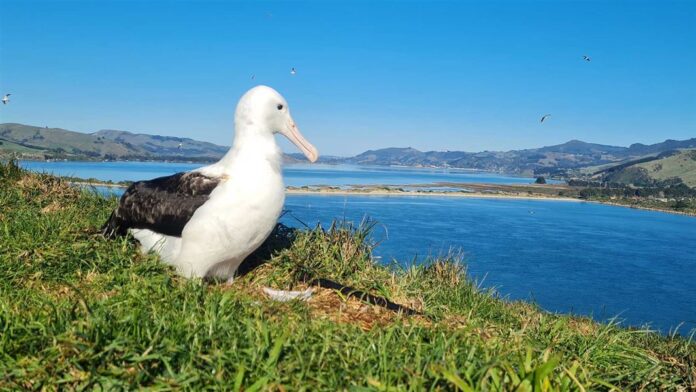Source: Department of Conservation
Date: 25 September 2021
And this year, those who watched Tiaki grow on the livestream can continue to follow her journey thanks to a satellite tracker that will give new understanding of where the albatrosses go in their early years.
The chicks have been growing steadily since hatching through January and February. The first to fledge, or leave the nest, took flight on 6 September. It is expected they will all have fledged by early October.
Department of Conservation Biodiversity Ranger Theo Thompson says it’s rewarding to see so many chicks leaving the colony after a successful season.
“If all of the remaining chicks fledge successfully, we will have a record-breaking year of 30 fledglings. Previously, the highest number of chicks we’ve had fledge is 28.
“Tiaki and the other chicks will spend the next four to 10 years travelling thousands of kilometres at sea without once touching the land, before eventually returning to Taiaroa Head to breed themselves.”
He says Tiaki has been a calm but talkative chick who has been healthy all season – providing great viewing for those tuning in to Royal Cam.
So far this season (since 1 December 2020), the livestream has had more than 2.3 million views, and was watched for about 400,000 hours.
Otago Peninsula Trust Ecotourism Manager Hoani Langsbury says this is a great time of year at the Royal Albatross Centre: “I get to be an empty nester for a short time after the chicks fledge, but the void is quickly filled by the coming season’s breeders returning.
“Pukekura is the only accessible location on the planet to observe the majestic comings and goings of the Northern Royal Albatross! Haere haumaru! Until the next Royal Cam chick is crowned.”
DOC Principal Marine Science Advisor Igor Debski says a 20g solar-powered satellite tracker, fitted to Tiaki on September 9, will provide valuable insight into where these birds go to forage during their early years.
“This will help us understand where they face risks as bycatch in fisheries.
“Tiaki’s parents both had trackers fitted in February. Her father LGK has travelled more than 65,000 kilometres since.”
The trackers are taped to feathers on the birds’ backs. They are designed to last about a year and will fall off when the albatross moults.
Background information
Royal Cam is a livestream of the toroa/northern royal albatross colony at Pukekura/Taiaroa Head, on the Otago Peninsula. The colony is the only mainland site in the world to view northern royal albatross in their natural habitat. Each year, the livestream focuses on one breeding pair as they raise a chick from an egg until it fledges (leaves the headland).
This year, Royal Cam focused on Tiaki, a female albatross that hatched on 24 January. Her parents LGL (female) and LGK (male) also reared Royal Cam chick Karere in 2019.
Tiaki means to care for, protect or save. Her name was chosen from more than 700 public submissions in the annual chick naming competition.
Toroa/northern royal albatross are one of the largest seabirds in the world, with wingspans up to 3m. They are a vulnerable species that has been affected by changes to habitat and climate and by some fishing practices.
They also reproduce slowly, with breeding pairs typically raising a chick once every two years.
DOC manages the albatross colony with the support of the Otago Peninsula Trust, Te Poari a Pukekura (Pukekura Co-management Trust, which governs Pukekura/Taiaroa Head) and Dunedin City Council. It has grown from one breeding pair in 1937 to more than 60 pairs in 2020.
Royal Cam joined Cornell Lab’s global network of live bird cameras last year, upgrading DOC’s existing web so the stream now features new capabilities like the ability to pan and night vision. Night vision gives international streamers the chance to tune in at any time of the day, when previously they would miss out on much of the albatross action due to different time zones.
Pukekura/Taiaroa Head is a significant site for its cultural and historic values, and for the other taonga species that live there. It is home to about 10,000 birds including red-billed gulls, little penguins, spotted shags, Otago shags, titi, and royal spoonbill.
Thirty northern royal albatrosses from the Motuhara colony in the Chatham Islands have also been fitted with trackers. While the Royal Cam birds have travelled predominantly within New Zealand waters so they can return regularly to feed Tiaki, some of the Motuhara birds have already travelled to the waters off southern South America, as far as southern Brazil
Contact
For media enquiries contact:
Email: media@doc.govt.nz



